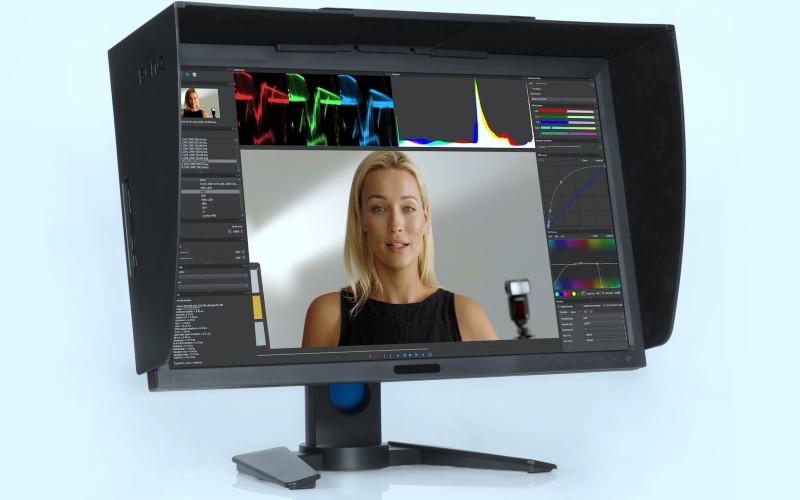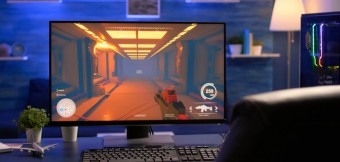How to choose a monitor for a computer?
We independently test the products and technologies that we recommend.

Monitor classification
According to the areas of application, monitors can be divided into six classes: universal, gaming, panel, professional, cinematic and old school.
Universal monitors are the most common and diverse: the diagonal can vary from 19 to 32". They are used both for office work (document flow, web surfing) and home multimedia entertainment (movies, games). Models with an emphasis on stylish design stand out with a subtle, barely noticeable frame. The most beautiful monitors, in our opinion, are produced by Philips and HP.
Gaming monitors differ from the rest primarily in high frame rates: 120, 144, 165 or 240 Hz versus 60 – 75 Hz in other classes. This minimizes the delay between pressing a key and responding to it on the screen, which is important primarily for multiplayer games. Additionally, support for NVIDIA G-Sync and AMD FreeSync technologies can be implemented, designed to eliminate image tearing (non-synchronous rendering of pixels) in games. Most gaming monitors in the range of ASUS, Acer and AOC.
 |
LCD panels are essentially TVs, devoid of a TV tuner and smart functions. They differ from monitors with a large diagonal (from 40") and a wall, rather than a desktop mount (usually, there is no leg in the kit).
Professional monitors are designed for serious photo and video processing. Extremely carefully calibrated at the factory (colour gamut is strictly 100 percent according to the AdobeRGB standard) and optionally equipped with a “visor” to eliminate excess room lighting and, as a result, even the slightest glare. The leaders in the production of professional monitors are NEC, Viewsonic and Dell.
 |
Monitors with an ultra-wide cinematic aspect ratio of 21:9 are designed for watching movies without black bars at the top and bottom, as well as for video editing (a long timeline fits). But for games, this format is controversial: not all games can produce an image without black bars on the sides, and not everything is comfortable to play if you can’t look at the whole thing on the screen. But on one ultra-wide monitor it is convenient to display images from two or even four sources at the same time — this technology is called Picture by Picture.
 |
Old-school monitors have an almost square 5:4 aspect ratio, which is not very suitable for modern movies and games. It makes sense to buy them now only if you are an inveterate "old believer" and stubbornly do not recognize new formats, or if you need a second monitor, but there is not enough space on the table for another widescreen model (see the article "How to connect a second monitor to a laptop or PC?").
 |
Matrix type
There are four widely used technologies for the production of liquid crystal matrix monitors: TN, IPS, PLS and VA. Let's consider each of them in detail.
TN(old name TN+Film) is the oldest and therefore the lowest quality type of matrices. Colour reproduction is dull, black often looks like dark grey, viewing angles, especially vertical ones, are small (at best 150 degrees, but often less). When viewed from above, the image brightens greatly, when viewed from below, it darkens. It is used mainly in cheap monitors of a small diagonal, allowing you to look at the screen almost at a right angle. Until recently, TN stood out against the background of more "colorful" technologies with a minimum response time (up to 1 ms), due to which it was used in gaming monitors. But now competitors have caught up with TN in this parameter and it can no longer boast of anything other than a low price.
IPS is a much more visually pleasing type of LCD matrices. It has high brightness and contrast (you should not focus on exact values, since each manufacturer measures them in its own way), as well as wide viewing angles (up to 178 degrees). Considering that IPS-matrices are produced by a relatively large number of companies (LG, Chimei, AU Optronics, etc.), image quality varies quite a lot. So, expensive models boast a colour gamut close to 100 percent AdobeRGB (therefore, only IPS matrices are suitable for professional photo and video processing), while low-cost models will have yellow instead of white, and purple instead of black. And here is another former disadvantage of IPS — a long response time of 8 – 20 ms — in recent years it has been completely eliminated (it has become 1 – 4 ms).
 |
PLS is an alternative to IPS developed and manufactured by Samsung. Slightly cheaper in production with the same, if compared by eye, image quality. It is used exclusively in Samsung monitors, due to which it has a more or less even quality, regardless of price. There is only one drawback compared to IPS — unnatural colour reproduction (up to 86 percent AdobeRGB). For example, the blue colour is more pronounced than the rest, which cannot be completely eliminated even by careful calibration. For games and movies, this is not a problem, but for photo processing it is a critical drawback.
VA(more precisely, its modern versions MVA, AMVA and AMVA +) — at first glance, they are in no way inferior to IPS and PLS: the same saturated colours. And in terms of black depth, VA has no equal at all (except perhaps AMOLED and OLED, which are not yet used in monitors). If you open a solid black picture on the screen, it will seem that it is turned off — that's how deep blacks the VA has. But VA also has its own “skeleton in the closet” — poor display of black halftones, which is especially noticeable in photographs with shaded areas (dark grey and black look the same). Because of this, details will be difficult to distinguish, for example, in films and games of the horror genre. The viewing angles of VA are narrower than those of IPS and PLS (up to 175 degrees). The colour gamut, like that of PLS, is unfortunately far from perfect (up to 75 percent of AdobeRGB). They specialize in VA monitors from BenQ and Iiyama.
Screen resolution and coverage
But what the type of matrix does not affect is the screen resolution. Even TN monitors can have increased Quad HD and even Ultra HD resolution(in fact, TN monitors are the most affordable 4K monitors). Full HD monitors are also built on any type of matrix, but HD models (more precisely, Windows-HD — not 1280x720, but 1366x768 pixels) are represented exclusively by low-cost TN models.
 |
HD and Full HD monitors with a frequency of 60 – 75 Hz are capable of connecting to a computer via both HDMI and DVI digital interfaces, as well as analogue VGA. The image quality will be the same. But 2K and 4K models, as well as Full HD with a refresh rate of 120+ Hz, are recommended to be connected via HDMI, with version 2.0, or Display Port. Otherwise, the image will not be transmitted at all, or it will be, but with a reduced frequency. But the development of technology for transmitting a video signal from a smartphone to an MHL monitor, unfortunately, has stalled. It is still supported by monitors, but is no longer used in new smartphones.
To avoid damage, a protective coating is installed on top of the LCD matrices, which can be the usual glossy, anti-reflective glossy, generally non-glare matte (but with an unpleasant effect of “iridescent sugar crystals” due to large matte grains) and semi-matt (the best option with fine grains).
 |
Three newfangled "chips" of monitors are curved and touch screen, as well as support for HDR technology. Curvature helps to solve the problem of image distortion at the edges of the monitor in the case of a very large diagonal (28+ inches). The touch sensor gives you the ability to control the computer with your fingers or draw with a stylus. The expanded HDR colour gamut allows you to display bright parts of the image with more contrast, and dark parts — slightly brighter. All this makes the picture more detailed. The fourth "chip" — support for stereoscopic 3D — turned out to be of little demand and is gradually leaving the market.
 |
Undeservedly little attention is focused on Flicker-Free technology, which eliminates the problem of a barely noticeable flickering of the monitor's LED backlight, which increases when the brightness is reduced. It is this negative flicker that tyres the eyes the most when working at a PC. And the health of the back and neck will be protected by the height-adjustable monitor leg. Although in extreme cases, you can put a cardboard box or a stack of books.
Additional functions
Optionally, monitors can be equipped with a USB hub for three or four ports, so that you do not have to reach for a computer under the table to connect, say, a flash drive. Also, some models have stereo speakers and a webcam, a room light sensor that automatically adjusts the brightness of the screen, and a user presence sensor in front of the PC that turns off the monitor to save energy.
findings
For the average PC user, a monitor with a diagonal of 24 – 27", 16:9 aspect ratio and Full HD resolution, IPS, PLS or VA matrix and a refresh rate of 60 Hz will be the best choice. Avid gamers should look at 120+ Hz models, and professional photographers and video editors should look at IPS models with a colour gamut close to 100 percent. With a gap for the future, you can purchase a monitor with an increased resolution of 4K or a 21:9 aspect ratio.
The curved shape of the matrix helps to plunge deeper into what is happening on the screen
Multipurpose solutions for work, games and multimedia content consumption.
Ultra-high UltraHD-resolution is increasingly penetrating the masses.
Data transfer, contactless payment by bank card and other "goodies" of NFC technology
Which hard drive is better for a laptop and which one for a desktop PC?
















